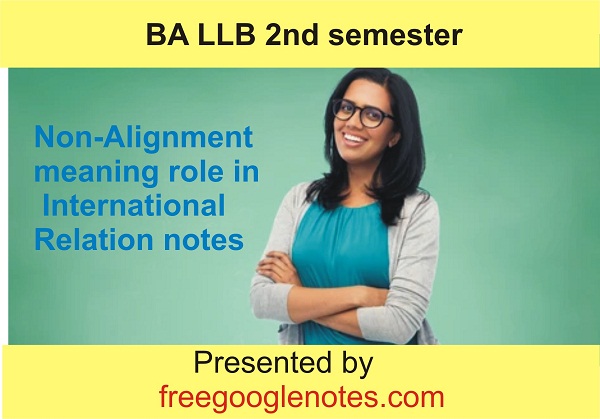Table of Contents
Non-Alignment meaning role in International Relation notes

Q.3. Discuss the meaning of motives “Non-alignment’. Write its and merits Non-alignment
Ans.-The term non-alignment denote different meaning to different people. Western scholars like Hans J. Morgenthau, George Liska, and Lawrence W. Marton, and others have preferred them “neutralism’ to ‘non-alignment. George Schwarzenberger refers to a number of terms like isolationism, non-commitment, neutrality, neutralization, unilateralism, and non-involvement, which are often taken as synonymous with non-alignment. But each term has a different meaning. Isolationism stânds for policies of aloofness. Non-commitment Teters to politics of detachment of other powers in a multi-corner relationship. Neutrality describes the political and legal status of a country
at war with respect to the belligerents. Neuralization means the political status of a particular state which it cannot give up under any circumstances (Switzerland is an example of a neutralized state). Unilateralism is identified with politics of calculated risks such as the destruction of own thermonuclear weapons at once,s instance. Non-involvement means keeping away from the struggle between the different upper power ideologies. Schwarzenegger says that non-alignment and the above-mentioned six concepts do not mean the same thing, and they fündamentally differ.
‘Non-alignment is a policy of keeping out of alliances in general and military pact in particular’. The term is very close to neutralism. the basic object of the two is ‘non-involvement in cold war’ in particular and in the actual war in general. Some scholars have used two interchangeably, but non-alignment has broader meanings. It means that a nation following such a policy need not be neutral under all circumstances. It. can participate actively in world affairs under exceptional circumstances. Non-alignment being an attribute of foreign policy is subject to change. That is why a change of government ina non-aligned country often results in a change of attitude. The new government has to make a specific declarátion to the effect of whether it would continue or abandon non-alignment, as happened in the case of India during the period 1977-80 under the Janta Party. Non-alignment taken in this context is not equivalent to neutralism or neutrality, which on the other hand is adopted as a result of an international agreement. The other hand is adopted as a result of the international agreement. The commitment to neutrality remains permanent and is not affected by a change in government unless the international agreement is abrogated.
In short, it can be said that political neutrality means keeping away from a particular issue while non-alignment means the same thing with a difference. Non-alignment also aims at keeping away from a particular conflict or issue but from a continuing international situation-the cold war. Since military alliances constitute an impórtant feature of the cold war, non-alignment naturally insists on keeping away from these alliances.
Non-Alignment and Antitlesis of Alignment
Before analyzing the factor which led to the development of. non-alignment it is relevant to study the factor which led to the traditional system of alliances.
The system of alliances or alignment is and was based on the
traditional thinking with regard to relations between the sovereign state, that international politics is nothing but a struggle for power amongst a number of small and large units each of which is aggressively inclined and each prepared to exercise superior power in the pursuit of an important interest On the assumption that the design of all government is to be independent. and at peace, alignment is in some degree involuntary-each an aligned static presumably considers that it has no option in the existing circumstances but to belong to an alliance. In the majority of cases, the alignment is neither imposed nor a consequence ot imposition. On the other hand, it is a deliberate response by a nation to a set of circumstances which in the view of its leaders compact it to seek the protection of another power. the basic factors which led to the conclusion of such alliances after 1945 was the cold war (where the small powers became aligned to other great powers as though they were directly involved in the common ideological struggle), the internal unrest (due to two conflicting groups supporting different ideologies when the ruling group in Philippines and Malaya entered into alliances), fear of subversion (when internal unrest was inspired or assisted by foreign agents for purpose of obtaining a strategic or political advantage).
J. W Burton is of the view that the cause of alignment may be Varied, they do not always relate to the struggle for power being waged by the leading nations, no do ideological conflicts associate with the struggle. Alignments arise but to preconceived notion regarding the behavior of nations out of subjective expectations, cut of long-standing enmities and traditional fears, out of internal unrest and out of policies which isolate nations, in many cases the major power conflict is but a cloak under which reasons for alignment are disguised.
The non-alignment is based on the widespread desire for national independence and non-involvement in the conflict of others. The policies of non-alignment are the policies every government would follow in an Ideal world of a sovereign state in which there were no power conflicts or threats to independence that called for special defense arrangements of alliances. There are widespread circumstances vnich inliucnce the country or countries to acccpt non-alignment, as the basis of their policy. Fost war naiionalism and anti-colonialism and thc pressing problem of Conomic under development are the background circunistances in Which non-alignment has flourished.
Factors Responsible for Adoption of Non-Alignment
The factor responsible for the adoption and development of non-alignment is given hereunder.
1. Nationalism. The most important feature. of the freedom movement in Asian and African countries was nationalism. It was not the nationalism of the west, a mounting devotion to onc’s own country or race but à movement to obtain freedom after a long and persistent struggle, and the people were conscious to preserve it at all costs. To preserve the freedom the nations were determined to follow a course whereby they did not become tools in the hands of big powers. Hence, they preferred to follow the policy of non-alignment.
2. Anti-colonialisn. The anti-colonial feeling which persisted in the countrics of Asia and Africa after attainment of frecdom also largely contributed to the growth of the policy of non-alignment. These powers were afraid that they may be again subjugated by thec colonial powers and werc, therefore, determined to keep of from these colonial powcrs. This could be possible by a avoiding membership of both the blocs and adopting an independent course of action by keeping out all sort of alliances. Their posítion was identical to the position of a child who dread fire.
3. Underdevelopment and economic aid. Most of the countries of Asia and Africa who gaincd independence were poor and underdeveloped. They were very keen to improve the standard to living of their people and promote systematic development of thcir country. As they nced capital and inancial assistance from the powers of both the bloc to achieve thcir objectives at a fast rate, they thought it proper to kcep off from political alignments and pursue a policy ot non-alignment.
4. Racial and cultural aspect. For a long time, the colonial powers had fed the Afro-Asian nations with the idea that they were racially as well as culturally backward. The fecling proved to be a boon in disguise and cvoked mutual sympathy among the people of the newly emerged states of Asia and Africa. Bcing victims of common economic exploitation and political domination by the European nations they felt a sense of affinity and decided to cooperate with cach other.
5. Need of peace for development. Finally, thc newly independent statcs wanted peace in the world so that they could conccntrate on their development. Consequently, they decided to kcep off from the military alliance and the two power blocs.
Motives of Non-Alignment
Every forcign policy has some definite motives, even though the basic motives of all foreign policies are to promotc the national interest. The chicf motives of non-alignment are as follows.
(i) Urge for independence in fonulation of fpolicy: All he crstwhilc colonies alter throwing off the bondage werc ken to secure their hard won independencc. As they werc economically, politically, and militarily quite weak and could not compete favorably with the older and stronger nations, they felt it desirable to keep out of power blocs so that they may be able to pursue an independent foreign policy.
(ii) Desire to avoid involvement in general war The non-aligned nation want to avoid entangling themselves in the various political feuds so that they may be able to concentrate fully on the cconomic and material development of their people. With this objective in mind hey generally. avoid an alliance with the two power blocs so that they may not be unwittingly dragged into the war. They non-aligned nations are quite aware that in case of general war they will not be able to escape its impact. Yet they are determined to avoid direct involvement is such wars as far as possible.
(iii) Preservation of world peace: Another motive of the non-aligned power is to preserve world peace. Non-aligned states feel that the course adopted by them is best designed to prevent war. They contend that throughout history, alliances and arms race have eventually resulted in war. Non-aligned nations are able to mediate between the power blocs, as they did in Korea, Indo-China and Congo. They may also supply impartial policemen and observers. They can provide manpower of the UN Emergency Force. Therefore, the ‘neutralists’ who constitute a larger group, can play an important role in avoiding war and preserving world pcace.
(iv) Economics Development: The non-aligned countries are under-developed. They must get with the work of social and economic development. They cannot afford to divert their limited resources to armaments and defense at the cost of neglect of the economic development of the country. Though countries like India arc often complied to organize the defense in the face hostile attitude of some of their neighbors, by and large, the non-aligned state prefers to. concentrate on the policy of economic development to better the conditions of their people.
(v) Moral argument: Non-alignment is considered to be a moral
doctrine while the systcem of alliance and counter-alliance is the clear manifestation of power politics’. The unaligned nations regard themselves ás morally superior even il, or perhaps because they are weaker and lack matcrial wealth. The non-aligned states consider it their proud duty to influence the international scene with moral force rather than by taking recourse to power.
(vi) To help UN to function successfully: Another moiive. so the. non-aligned nations is to ensure prescrvation . that UN unctions successfully fulfilling its objcctives especially of preservation of world peace and .cconomic developmcnt. This is possible only if this forum is freed from the game of power politics. Thc non-aligncd states who constitute the third forces can play a uscful role in international politics by judging cach issue on its merits and finding a viable solution.
(vii) Economic and technical assistance: Non-aligned nations receive concrete advantages by remaining friendly with all the big powers. They are able to secure economic and technical assistance from both blocs. They can also receive help from one bloc when threatened or actually attacked by the other power. Sometimes, this. attitude is considered immoral as it amount to playing of one side against the other. But it is the classical tradition of politics generally and international politics in particular, that the state must protect its interests by all sorts of methods.
Evaluation of the Concept
Scholars have expressed conflicting views regarding the significance of the concept. While some have greatly lauded it, the others bitterly criticize it. The main points of criticism against the non-alignment arc as follows:
1. The doctrine is unclean James Burton has said that “there has been no full treatmcnt of the concept, on analysis and precise description, no exposition through which others might estimate the significance and future prospects of policies of non-alignment.”
2. Not a model of international behavior The exponents of non-alignment claim that the concept is of great signilicancc in so far as a model of international bchaviour. which all countries should follow in the interests of peaceful relations. It serves as a solution for the grave problem of the nuclear age. But thc aligned nations, small and large appear to have the wrong image of non-alignment for which they deduce that it a “shifting policy of unrealistic expcricnce of black main and of
irresponsibility likely not to be permanent and to be even a dangr to the world peacc” (J. W. Burton).
4. Represcnis of the policy of national self-interest. Wcstern scholars have alleged that non-alignment is nothing but a policy designed to fulfill he sclfish interest of the nations professing it. No doubt this is the characteristics of all forcign policics, but the general expression that non-aligned countries are not self-seekers has not been admitted by western scholars. Therefore, like all other concepts-laissez-faire, the balance of power, party parliamentary goverament, ctc.-this too has developed out of expediency and sclf-interest.
5. The concept is confused with olher tens: Quite often the concept of non-alignment is confused with terms like ncutralism. Even the advocates of non-alignment like the U.N. of Burma once said in a specch, This policy (non-alignment) has been called neutralism in the cold war. Perhaps that is the right name for it.” Therefore, some advocates and proponents of the doctrine themselves are not very clear as to the correctness of thc term.
Merits
Non-alignment is not an unmeritorious system. It has it predominant merits which have led most of the Afro-Asian countries to adopt it as the basis of their foreign policy. The chief merits are as follows.
1. Preservation of world peace. All politics including international politics are struggling for power. This gives rise to the alliance and counters alliances, armaments race, and militarism, etc. The non-aligned nations try to keep out of this power struggle which is ultimately conducive to world peace.
2. Preservation of Independence. The nation which have adopted the policy of non-alignment were once under the political subjection of the great powers. They had to wage a hard and long struggle to win thcir political independence. As they do not want to lose their hard-won independence they try to kecp out of world power struggle lest their independence may be jeopardized again.
3. Economic aid and development. Non-aligned countries can’ win the favour of both the blocs and receive economic assistance for their development from both. For example, India received the maximum aid from the Soviet Union as well as USA. It has been cstimated that India received up to 1962 $ 2726m from USSR and $ 963m from USA while Pakistan received only $1329m in total: This clearly show that India as


